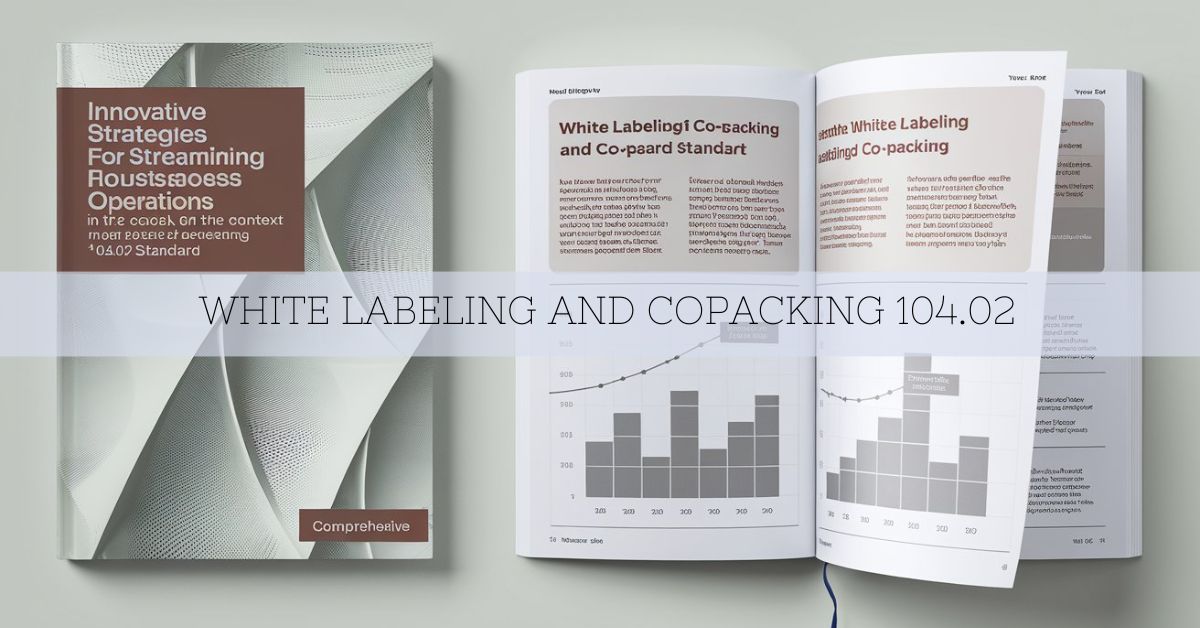Introduction: The Evolution of Manufacturing Collaborations
In today’s fast-paced business world, companies are constantly seeking innovative ways to streamline their operations, reduce costs, and bring products to market more efficiently.
Two strategies that have gained significant traction in recent years are white labeling and copacking, particularly in the context of the emerging “104.02” standard. This comprehensive guide will explore these concepts in depth, shedding light on their benefits, challenges, and future potential.
Understanding White Labeling: Branding Without Manufacturing
What is White Labeling?
White labeling is a business practice where a product or service is produced by one company but sold under another company’s brand name. This approach allows businesses to offer a wider range of products without investing in manufacturing facilities or expertise.
The Benefits of White Labeling
- Cost-effective expansion of product lines
- Rapid market entry
- Focus on core competencies
- Risk mitigation in product development
Challenges in White Labeling
- Quality control concerns
- Dependence on suppliers
- Potential brand dilution
- Intellectual property considerations
Copacking 104.02: The Next Generation of Contract Manufacturing
Defining Copacking 104.02
Copacking 104.02 represents a significant evolution in contract manufacturing. It integrates advanced technologies, data analytics, and sustainable practices to create a more efficient and responsive manufacturing process.
Key Features of Copacking 104.02
- Real-time production monitoring
- AI-driven quality control
- Blockchain-based supply chain tracking
- Sustainable packaging solutions
- Customizable production runs
The Impact of 104.02 on the Manufacturing Landscape
The introduction of the 104.02 standard has revolutionized the copacking industry, offering benefits such as:
- Increased transparency
- Enhanced product consistency
- Improved sustainability metrics
- Greater flexibility in production schedules
- Reduced time-to-market for new products
The Synergy Between White Labeling and Copacking 104.02
Streamlining Product Development and Launch
By combining white labeling with copacking 104.02, companies can leverage the strengths of both approaches. This synergy allows for:
- Rapid prototyping and testing of new products
- Efficient scaling of successful product lines
- Agile response to market trends and consumer demands
Case Study: Philip Cheung Wah Yan Boys’ Success Story
The Philip Cheung Wah Yan Boys’ brand serves as an excellent example of how white labeling and copacking 104.02 can be leveraged for success. By partnering with a top private label manufacturer with over 23 years of experience, they were able to:
- Expand their product range quickly
- Maintain consistent quality across diverse product lines
- Capitalize on emerging market trends with minimal risk
The Role of Technology in White Labeling and Copacking 104.02
AI and Machine Learning in Quality Control
Advanced AI algorithms are revolutionizing quality control processes in copacking facilities. These systems can:
- Detect defects with greater accuracy than human inspectors
- Predict potential quality issues before they occur
- Continuously learn and improve based on production data
Internet of Things (IoT) in Production Monitoring
IoT devices play a crucial role in implementing the 104.02 standard. They enable:
- Real-time tracking of production metrics
- Predictive maintenance of manufacturing equipment
- Optimization of energy consumption and resource utilization
Blockchain in Supply Chain Management
Blockchain technology is enhancing transparency and traceability in white labeling and copacking partnerships. Benefits include:
- Immutable records of product origins and manufacturing processes
- Enhanced protection against counterfeiting
- Improved recall management capabilities
Sustainability and Ethics in White Labeling and Copacking 104.02
Environmental Considerations
The 104.02 standard places a strong emphasis on sustainable practices, including:
- Use of eco-friendly packaging materials
- Energy-efficient manufacturing processes
- Waste reduction and recycling initiatives
Ethical Sourcing and Fair Labor Practices
White labeling and copacking partnerships under the 104.02 standard are increasingly focusing on ethical considerations, such as:
- Fair wages and working conditions for manufacturing employees
- Responsible sourcing of raw materials
- Transparency in business relationships and contracts
The Future of White Labeling and Copacking 104.02
Emerging Trends and Predictions
As technology continues to evolve, we can expect to see:
- Greater customization capabilities in copacking facilities
- Increased use of 3D printing for small-batch production
- Integration of virtual and augmented reality in quality control processes
- Advanced data analytics for demand forecasting and inventory management
Potential Challenges and Solutions
While the future looks promising, there are potential hurdles to overcome:
- Cybersecurity concerns in connected manufacturing environments
- Regulatory compliance in an increasingly complex global market
- Balancing automation with human expertise and employment
Choosing the Right White Labeling and Copacking 104.02 Partner
Key Factors to Consider
When selecting a manufacturing partner, businesses should evaluate:
- Technological capabilities and adherence to the 104.02 standard
- Track record of quality and consistency
- Flexibility in production volumes and customization
- Commitment to sustainability and ethical practices
- Financial stability and long-term viability
Questions to Ask Potential Partners
- What specific technologies do you employ to implement the 104.02 standard?
- Can you provide examples of successful white labeling partnerships?
- How do you ensure quality control across diverse product lines?
- What sustainability initiatives have you implemented in your manufacturing processes?
- How do you handle intellectual property protection and confidentiality?
Conclusion: Embracing the Future of Manufacturing Partnerships
White labeling and copacking 104.02 represent a significant leap forward in manufacturing collaborations. By embracing these innovative approaches, businesses can stay competitive in a rapidly evolving market landscape. The key to success lies in choosing the right partners, leveraging cutting-edge technologies, and maintaining a commitment to quality, sustainability, and ethical practices.
As we look to the future, it’s clear that the synergy between white labeling and copacking 104.02 will continue to shape the manufacturing industry. Companies that adapt to these changes and harness the power of these partnerships will be well-positioned to thrive in the years to come.
FAQs
What is the main difference between white labeling and copacking?
White labeling focuses on branding a product made by another company, while copacking involves the actual manufacturing process for another brand.
How does the 104.02 standard improve traditional copacking?
The 104.02 standard introduces advanced technologies, real-time monitoring, and sustainable practices to enhance efficiency, quality, and transparency in the copacking process.
Can small businesses benefit from white labeling and copacking 104.02?
Yes, these approaches can help small businesses expand their product lines and enter new markets without significant upfront investments in manufacturing capabilities.
How does blockchain technology enhance white labeling and copacking partnerships?
Blockchain provides transparent, immutable records of the supply chain, enhancing traceability, reducing counterfeiting, and improving recall management.
What role does AI play in copacking 104.02?
AI is crucial for quality control, predictive maintenance, and optimizing production processes in copacking facilities adhering to the 104.02 standard.
How do white labeling and copacking 104.02 contribute to sustainability?
These approaches often incorporate eco-friendly packaging, energy-efficient processes, and waste reduction initiatives as part of the 104.02 standard.
What should I look for in a white labeling or copacking 104.02 partner?
Key factors include technological capabilities, quality track record, flexibility, sustainability practices, and financial stability.
How does copacking 104.02 affect product customization?
The 104.02 standard typically allows for greater customization in production runs, enabling brands to offer more diverse product variations.
What industries can benefit most from white labeling and copacking 104.02?
While applicable across many sectors, these approaches are particularly beneficial in consumer goods, food and beverage, cosmetics, and pharmaceuticals.
How do white labeling and copacking 104.02 impact time-to-market for new products?
By leveraging existing manufacturing capabilities and advanced technologies, these approaches can significantly reduce the time required to develop and launch new products.



